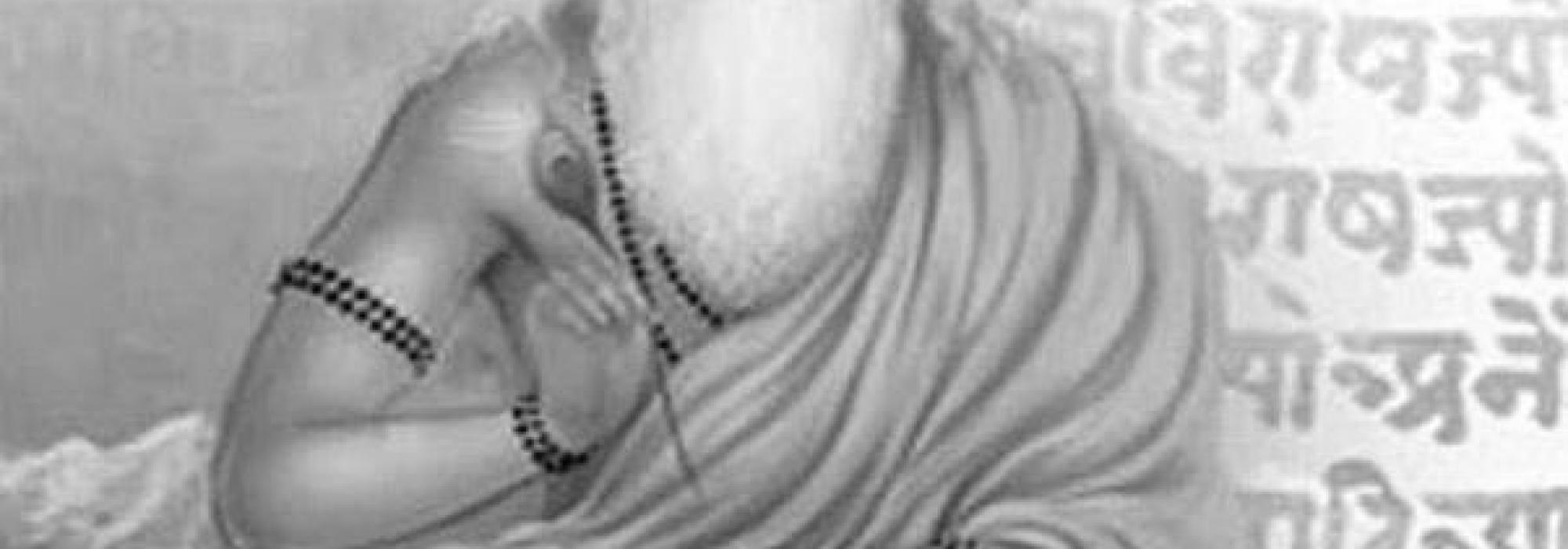Complexity of Characters
This selfsame impulse is visible in the characters of Duryodhana and such others in a tangential fashion. Nobody regards Duryodhana and Dusshyasana as fools. There is no dearth of “analysts” or critics who regard Duryodhana as a tragic hero based on the premise that his behavior and actions are natural to his basic character. The dense intensity of blind attachment that pervades a person who is driven by desire and anger is depicted in the Mahabharata in an eye-arresting manner.
We observe the same complexity of character even in Bhishma. Sri Krishna himself praises Bhishma’s sagely wisdom and instructs Yudhishtira to receive this wisdom from him and contemplate upon it so that such valuable knowledge is not lost. Even such a sagely person fails to perform his Dharmic duties owing to self-declared oaths and a sense of indebtedness to the person who has given him food.
The intellect supplies the necessary faculty to distinguish between right and wrong. However, it is not certain that one can depend solely on the directions of the intellect in all situations. This is because, most of the time, the intellect works like a machine in the fashion of “input-output.” If we wish to derive the maximum utility, the intellect must be refined by culturing it.
Both Dhritarashtra and Vidura are “intelligent” at one level. The difference is this: Dhritarashtra’s intellect is influenced by attachment and base impulses while Vidura’s intellect is shaped by refinement. Bhagavan Veda Vyasa has nicely highlighted this dichotomy.
There is no dearth of stark situations like that of the public disrobing of Draupadi in the epic. It is far more life-enriching to interpret such grim events as the bubbles of that great life-flow than try to assign them meanings at the superficial level. This approach and attitude is the ultimate fruit of studying literature (in the sense of Kavya).
Dharma is Multistoried
Maharshi Vishwamitra had to consume meat during extreme famine, when there was acute scarcity of food just so that he could survive. Such incidents themselves teach us the lesson that one must transcend the letter, raise up to the level of the spirit and interpret them from that higher plane. Dharma is multistoried. “gahanā karmaṇo gatihi (Bhagavad Gita 4:17)” and other well-known maxims convey the same message. The summary—the form of external situations are not decisive. The hidden purpose of these events which seem bizarre at the superficial level is to show the fact that the continual flow of Dharma is dynamic and deep. When we embark on an investigation of the symbolic, the instructiveness of the Mahabharata’s characters becomes easily accessible to the mind.
As an illustration, we can examine the character of Dhritarashtra. The meaning of his name: “He who has taken the overlordship of the kingdom in his embrace.” In other words, he has owned that which does not rightfully belong to him. Indeed, Dhritarashtra’s overlordship is in name only. Although he called himself the king, the reins of the administration actually were in the hands of his evil sons. The tenet that immediately flashes to us from this is this—people who think that they have accomplished many great things in this world are actually living an illusion. In fact, Dhritarashtra also stands as an unparalleled example of the supreme difficulty of overcoming such delusions. Equally, Dhritarashtra himself declares the power of this blind attachment which in his case manifests as fatherly love:
svam vai dehaṃ parahitostyajayate
ko nu brūyāt samatāṃ anvavekṣya ||
“In the name of impartial thinking, how is it correct to sacrifice one’s own body or that which is born from one’s body for the benefit of others?”
The Divine and Destiny
Now we can examine the characters of Sri Krishna and Arjuna.
Arjuna is the symbol of the Jivatma (Individual Self) and Sri Krishna as the symbol of the Paramatma (Universal/Eternal Consciousness). Although Arjuna is far nobler than ordinary people, in the overall assessment, we observe purely human elements in him. The message of the Mahabharata is to elevate oneself from that level. Even Sri Krishna subjected himself to an inner discipline and followed worldly rules and elevated himself. Although he was omnipotent, throughout the Mahabharata, we notice how he placed great importance to following manmade laws and rules. Thus, we observe Sri Krishna at various stages and on various planes: from the mundane to the divine.
At one point, Krishna says with great emotion, “Pandavas are akin to my life.” The same Krishna elsewhere dispassionately declares after the Yadavas annihilate themselves through infighting, “The weight of the earth has thankfully reduced.” Sri Krishna’s character has been created to show the unity of instructive qualities. The Krishna who fought the war on Arjuna’s side is different; the Krishna in his True Nature is different.
Similar to how in the Upanishads, the Guru helped Svetaketu get the revelation of the Absolute Blissful nature of the Atman through the “tat tvam asi” phrase, Sri Krishna, in the Bhagavad Gita helps Arjuna to realise the unity between Jivatma and Paramatma. It is also pertinent to recall that “Krishna” is one of the names of Arjuna. When the veil of Maya that blocks the Jiva is lifted, the Paramatma is realized.
The Mahabharata has a Universal Canvas
nārāyaṇaṃ namaskṛtya naraṃ caiva narottamam |
devīṃ sarasvatīṃ vyāsaṃ tato jayamudīrayet ||
The Mahabharata begins with this invocatory verse. While this customary, auspicious verse appears like a prayer to Deities on plain sight, when we get into the depths, we discern a greater insight therein. By means of this invocation, Bhagavan Veda Vyasa has hinted at the universality of the work by fusing the elements of Jiva, Paramatman, and the ardent seeker (Sadhaka) together in one place; he has suggested that all three are the manifesting ingredients of the same, indivisible Principle.
To be continued














































